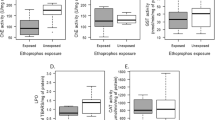Abstract
Interspecies differences in “B” esterases were evaluated in seven species of wild birds in order to investigate their different susceptibilities to organophosphorus (OP) insecticides. The relationship between “B” esterases and body size and the influence of feeding habits in the evolution of esterase activities were explored. An in vitro inhibition test was carried out with paraoxon and azinphos methyl oxon in order to investigate the role of equilibrium binding parameters (acetylcholinesterase/organophosphorus compounds affinity) in determining susceptibility of the different species to parathion and azinphos methyl. Esterase activities were different in all species. The smallest bird studied (the sparrow) had the highest brain acetylcholinesterase (AChE) and plasma carboxylesterase (CbE) activities. The largest bird (the cormorant) had the lowest level of both activities. For microsomal CbE, the coot had the highest activity. An inverse correlation was found between brain AChE and plasma CbE activity in relation to body size. Omnivorous species showed the highest brain AChE and plasma CbE activities which were low in species with a specialised diet. The in vitro inhibition test demonstrated the active involvement of equilibrium binding parameters in determining different susceptibilities to these contaminants in birds.
Similar content being viewed by others
References
Brealey CJ, Walker CH, Baldwin BC (1980) A-esterase activities in relation to the differential toxicity of pirimiphos-methyl to birds and mammals. Pestic Sci 11:546–554
Chambers JE, Levi PE (1992) Organophosphates. Chemistry, Fate, and Effects. Academic Press, NY, p 443
Decarie R, DesGranges JL, Lepine C, Morneau F (1993) Impact of insecticides on the American robin (Turdus migratorius) in a suburban environment. Environ Pollut 80:231–238.
DeWeese LR, McEwen LC, Settimi LA, Deblinger RD (1983) Effects on birds of fenthion aerial application for mosquito control. J Econ Entomol 76:906–911
Ellman L, Courtey KD, Andreas V Jr, Featherstone RM (1961) A new rapid colorimetric determination of cholinesterase activity. Biochem Pharmacol 7:391–393
Fossi MC, Massi A, Leonzio C (1994) Blood esterase inhibition in birds as an index of organophosphorus contamination: field and laboratory studies. Ecotoxicology 3:11–20
Fossi MC, Massi A, Lari L, Focardi S, Leonzio C, Renzoni A (1995) Interspecific differences in mixed function oxidase activity in birds: relationship between feeding habits, detoxication activities and organochlorine accumulation. Environ Pollut 90:15–24.
Gomori G (1953) Human esterases. J Lab Clin Med 42:445–453
Greig-Smith PW (1991) Use of cholinesterase measurements in surveillance of wildlife poisoning in farmland. In: Cholinesterase-inhibiting insecticides, Vol 7 Mineau P (ed), Elsevier Science Publishing Co, NY, pp 127–150
Henny CJ, Blus LJ, Kolbe EJ, Fitzner RE (1985) Organophosphate insecticide (famphur) topically applied to cattle kills magpies and hawks. J Wild Manage 49:648–658
Hill EF, Murray HC (1987) Seasonal variation in diagnostic enzymes and biochemical constituents of captive northern bobwhites and passerines. Comp Biochem Physiol 87B (4):933–940
Hill EF (1988) Brain cholinesterase activity of apparently normal wild birds. J Wildl Dis 24:51–61
ISTAT (Istituto Nazionale de Statistica) (1993) Statistiche dell'agricoltura, zootecnia e mezzi di produzione. Anno 1991. Annuario no° 39
Johnston G, Collett G, Walker C, Dawson A, Boyd I, Osborn D (1989) Enhancement of malathion toxicity to the Hybrid Red-Legged partridge following exposure to Prochloraz. Pesticide Biochemistry and Physiology 35:107–118
Lubet RA, Nims RW, Mayer RT, Cameron JW, Schechtman LM (1985) Measurement of cytochrome P450 dependent dealkylation of alkoxyphenoxazonesin hepatic S9s and hepatocyte homogenates: effects of dicumarol. Mutation Res 142:127–131
Mineau P (1991) Cholinesterase-inhibiting insecticides. Elsevier Science, Amsterdam, The Netherlands.
Murphy SD, Lauwerys RR, Cheever KL (1968) Comparative anticholinesterase action of organophosphorus insecticides in vertebrates. Toxicol Appl Pharmacol 12:22–35
Niethammer KR, Baskett TS (1983) Cholinesterase inhibition of birds inhabiting wheat fields treated with methyl parathion and toxaphene. Arch Environ Contam Toxicol 12:471–475
Ronis MJJ, Walker CH (1985) Species variations in the metabolism of liposoluble organochlorine compounds by hepatic microsomal monooxygenase: comparative kinetics in four vertebrate species. Comp Biochem Physiol 82C:445–449
Tank SL, Brewer LW, Hooper MJ, Cobb GP, Kendal RJ (1993) Survival and pesticide exposure of northern bobwhites (Colinus virginianus) and eastern cottontails (Sylvilagus floridanus) on agricultural fields treated with Counter 15G. Environ Toxicol Chem 12:2113–2120
Thompson HM, Mackness MI, Walker CH, Hardy AR (1991) Species differences in avian serum B esterases revealed by chromatofocusing and possible relationships of esterase activity to pesticide toxicity. Bioch Pharmacol 41(8):1235–1240
Walker CH, Knight GC, Chipmen JK, Ronis MJJ (1984) Hepatic microsomal enzymes monooxygenases of sea birds. Mar Environ Res 14:416–419
Walker CH, Thompson HM (1991) Phylogenetic distribution of cholinesterases and related esterases. In: Cholinesterase-inhibiting insecticides, Vol 1, Mineau P. (ed), Elsevier Science NY pp 1–17
Wang C, Murphy SD (1982) Kinetic analysis of species difference in acetylcholinesterase sensitivity to organophosphate insecticides. Toxicol Appl Pharmacol 66:409–419
Fossi MC, Massi A, Lari L, Marsili L, Focardi S, Leonzio C, Renzoni A (1995) Interspecies differences in mixed function oxidase activity in birds: relationship between feeding habits, detoxication activities and organochlorine accumulation. Environ Pollut 90 1:15–24
Westlake GE, Bunyan PJ, Martin AD, Stanley PL, Steel LC (1981) Organophosphorus poisoning: Effects of selected organophosphorus pesticides on plasma enzymes and brain esterases of Japanese quail (Coturnix coturnix japonica). J Agric Food Chem 29:772–777
Westlake GE, Martin AD, Stanley PI, Walker CH (1983) Control enzyme levels in the plasma, brain and liver from wild birds and mammals in Britain. Comp Biochem Physiol 76C:15–24
Wiemeyer SN, Sparling DW (1991) Acute toxicity of four anticholinesterase insecticides to American kestrels, eastern screech-owls and northern bobwhites. Environ Toxicol Chem 10:1139–1148
Wilson BW, Hooper MJ, Littress EE, Detrich PL, Hansen ME, Weisskopf CP, Sieber JN (1991) Orchard dormant spray and exposure of red-tailed hawks to organophosphates. Bull Environ Toxicol 47:717–724
Walker CH (1980) Species variations in some hepatic microsomal enzymes that metabolize xenobiotics. Prog Drug Metabol 5:113–164
Author information
Authors and Affiliations
Rights and permissions
About this article
Cite this article
Fossi, M.C., Lari, L. & Casini, S. Interspecies variation of “B” esterases in birds: The influence of size and feeding habits. Arch. Environ. Contam. Toxicol. 31, 525–532 (1996). https://doi.org/10.1007/BF00212436
Received:
Revised:
Issue Date:
DOI: https://doi.org/10.1007/BF00212436




